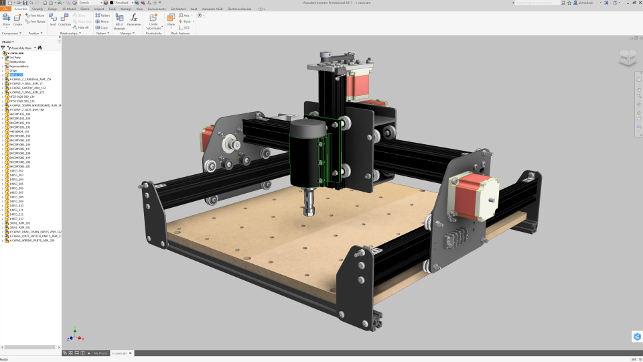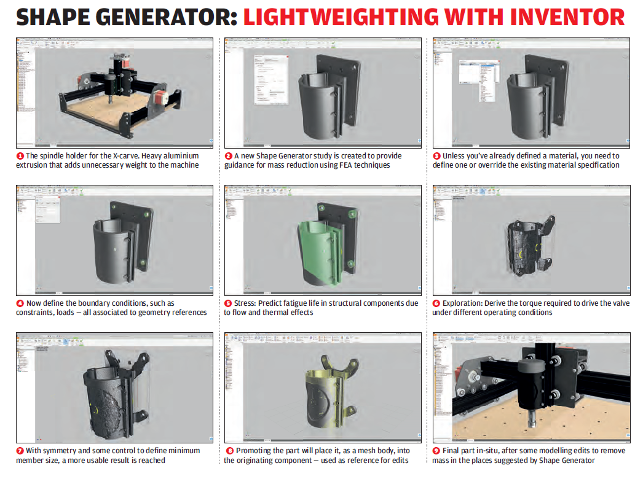Inventor 2017 – Autodesk Inventor is going through something of a renaissance in terms of development. With three major releases a year, it is gaining some very interesting tools. We take a look at the highlights of the latest release
Inventor is Autodesk’s flagship design, engineering and production system. It has been on the market a good long while now and as such features a rich set of functionality.

It might be over a decade old , but Inventor looks and feels like a modern, current system with much to offer
This includes prismatic part modelling, complex surfacing and assemblies as well as more specialised processes, such as wire routing, harness design and tube and pipe design.
Of course, given Autodesk’s legacy with AutoCAD, users can also create the vital production drawings that are key to getting products manufactured.
While Autodesk’s cloud-based ambitions with Fusion 360 have gained the headlines in recent years, Inventor has been undergoing its own development. Service Packs (biannually alongside the major updates) are introducing new features and functions as well as fixing those pesky bugs. So let’s take a look at the first major release for the 2017 release cycle.
Inventor 2017 – user experience
There are no massive user interface changes in Inventor, which is good news for existing users. That said, there are a few tweaks that will make life easier or more efficient.
The first is that the UI has been adapted to make the most of 4K screens. Icons will scale and look correct. A relief for those who’ve had to search for their spectacles in order to find the fillet option.
The second is that there are now a number of keyboard shortcuts to control visibility of the parts that are being worked on. Parts themselves can be made temporarily transparent, which is useful for seeing inside a component (or set of components) without having to change their ‘appearance’ permanently.
Data exchange
Those that follow the Inventor progression path, might be aware that the last few releases have seen Autodesk focus on making the work with imported data more effective. In particular, if you’re looking to maintain a link to that originating data to better handle design changes.
While we covered it on the 2016 release, it’s worth a recap.
Inventor’s AnyCAD technology allows data to be brought in from a variety of sources (such as native data formats). But instead of doing a full scale import and conversion to Inventor format, the system hides the process from the user and maintains the link to that originating data.
Essentially, if you update the originating file, Inventor will recognise the change and update where it appears accordingly.
While it’s not removing the conversion process, the fact that links are maintained associatively, make it much more usable.
Of course, once you need to perform edits on those ‘third party’ parts, you’ll need to do the full conversion, but until that point, they act like native Inventor geometry, so can be measured, inspected, assembled etc.
While this hasn’t changed massively for this release, there is the addition of support for referencing STEP files as well as to the native formats including Catia, NX, Creo, SolidWorks, Alias and Pro/Engineer.
Inventor 2017 – 3D sketch revisited
For those working with tube, pipe and many other types of features that naturally conform to a planar sketch, the work done on improving the usability of 3D sketch creation is going to be a massive boost to productivity.
While the previous tools worked, they were more than a little cumbersome in their approach, particularly given how other modelling operations are now much more dynamic and freeform.
The new 3D Sketch environment fixes this, giving you tools to quickly create not only reference points where needed, but also relationships, fillets, blend curves etc.
What’s also interesting is the manner in which the 3D sketches can be both constrained to existing points of reference while enabling those all important tweaks to get both the function of the part right and the desired aesthetic.
If you’re a long time Inventor user, it’s worth spending time looking into the specifics. In particular, the @@ command that allows you to drag and drop points in 3D space more fluidly than ever before.
Also worthy of note is that elements of a 3D sketch can be cut/copy and pasted both within a single sketch or between separate ones. This means that if you’re trying to construct a tricky surface you can copy/paste and tweak to get it just right, rather than starting from scratch each time.
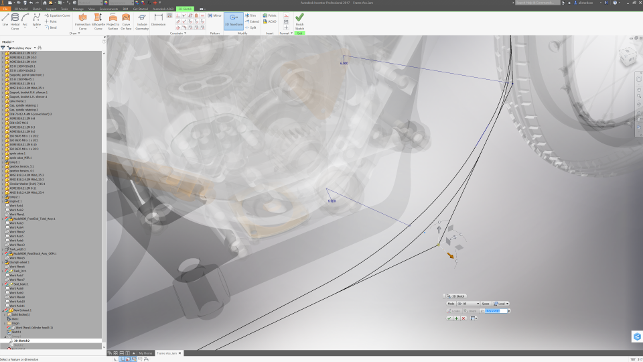
The new 3D sketch creation and editing tools gives you more fluid edits as well as a rich set of constraints
Inventor 2017 – part modelling
Moving onto 3D feature construction updates, there’s already a rich set of tools within Inventor for everything from prismatic parts, surfaces, t-splines through to sub division modelling (introduced a couple of release cycles ago).
With each release, these get attention that increments the functionality and adds a little more capability to already mature technologies. That said, there are a few that deserve to be highlighted for the 2017 release.
The first relates to the construction of sketch-based patterns. Unlike the traditional patterning tools that focus on the use of ordered, linear or radial patterns, sketch driven patterns afford you much more flexibility in terms of where features (or indeed, components) are copied to.
Essentially, you create a sketch, add a point in position where you want it and the system will proliferate each of those points with a copy of your selected feature (or feature set).
This works with both 2D planar sketches as well as 3D sketches, so the possibilities are pretty much unlimited.
The latter is particularly useful for creating automated feature creation across a more complex surface or part form.
Also on the patterning front, there’s been some work done on how features or parts are rotated in radial patterns. Where previous radial patterns would rotate the features around the selected axis, the new controls allow you to maintain the orientation of the feature.
The last new feature that I wanted to talk about with regards to part modelling is the Relationship browser. While in assembly mode, we’re all familiar with being able to visualise the relationships between different parts quite easily, this isn’t always the case for parts.
Particularly where inter-relationships between different features aren’t always clear — especially if you didn’t build the part yourself.
The new Relationship browser lets you select a feature and then gives you a split dialog that shows the parent features and then the children features, so you can see where edits may have impact both upstream and downstream in the feature history.
Inventor 2017 – working with mesh data
We’re all familiar with the trials and tribulations of working with mesh data, whether that’s OBJ, STL or another format, which have become more prevalent with the rise of 3D printing.
While most of the struggles to date have revolved around getting consistent and reliable data out of the workhorse design systems, a more recent challenge has involved doing it the other way around and importing it.
Autodesk Inventor 2017 starts to address this with tools that allow you to actually do something with mesh-based data other than just display it.
The geometry isn’t merely held as a graphics reference anymore, but rather, can be measured and inspected in a deeper manner.
Interestingly, the system also interprets the mesh, where possible, to allow you to select facets that lie in the same plane or confirm to circular relationships. This means that mesh parts can be used within the context of an assembly, joints and constraints placed, without the need to remodel the whole thing.
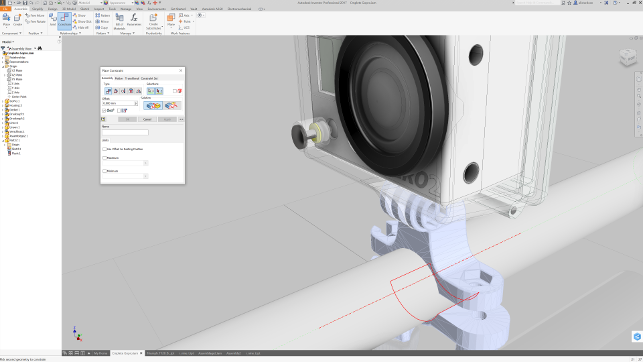
Inventor 2017 lets you work with mesh data in a more constructive manner — measurements can be taken and such items can be integrated into assemblies where needed
Shape generator
Introduced into the 2016 release cycle (at Service Pack 2 and 3), Shape Generator is a topology optimisation add-in within the Stress Analysis environment in Inventor Professional.
Essentially, it works much like the other topology optimisation tools you might be familiar with, focusing on the goal of mass reduction. We’ve put together an example workflow within this review, but it’s worth discussing some of that in a little more detail.
Like most topology optimisation tools, Shape Generator requires that you start with a design space, whether that’s built for the purposes of optimisation, based on an existing part or, indeed, imported geometry.
You then kick off the Shape Generator study and define the materials, the loading conditions and the forces, pressures and other factors that infl uence the behaviour of that part.
The next step is to then define any ‘keep out’ regions. These are the parts of the model that you need to retain, whether they’re functional or aesthetic.
This is a pretty simple process of selecting reference geometry and dragging a box or cylinder to size. There can be multiples added to a part, but you need to bear in mind that if you over restrict the design shape, you’ll need to adapt the mass reduction target. Inventor will warn you if this is the case.
There are also a group of parameters within the optimisation set-up process that are worth exploring as these have expanded for this release. The first is that you can defi ne planes of symmetry, which is done nice and simply from a dialog.
The second is that you now have control over the minimum member size — again, be careful that you don’t set it too low, otherwise you’ll need to adapt the mesh size accordingly.
Once everything is in place, you then run the simulation. You’ll end up with the type of results we’ve all come to expect for this type of work, a mesh. This can then be promoted into Inventor’s parts from which it’s derived or saved out as an STL.
This can either then be used for 3D printing (although not likely as is) or used as a guide for more formal redesign work, as it’ll give you an indication of where material can be safely removed without impacting the structural integrity and required performance of the part.
Inventor 2017 – 3D PDF output
This is looking to be an interesting year for the 3D PDF format.
While it has been around for a good while now, we’re finally starting to see better support for it from mainstream players. Autodesk Inventor 2017 gets 3D PDF output courtesy of Anark’s Core technology.
This allows you to select your part or assembly file, export it to PDF with a number of options.
The first is that you have control over the quality of the tessellation of the model within that PDF (you can also use Inventor’s existing tools to mask confidential IP) as well as to defi ne the meta data that’s inserted into the PDF as well (which is extracted from the part or assemblies iProperties).
There’s also an option to attached a STEP file to the PDF as well, so those receiving or using it can inspect the geometry and work with it (should the need exist).
The end result is a nicely constructed PDF file with the usual visualisation window and all the editing and visualisation/inspect tools (pan, zoom, rotate, sectioning) that can then be used as the basis of your downstream application. Whether that’s generating an RFQ, sending data to suppliers or making it available to customers.
It’ll also give you a means to get that data into other PDF related workflows, whether you’re using Theorem’s or Techsoft 3D’s Tetra 4D.
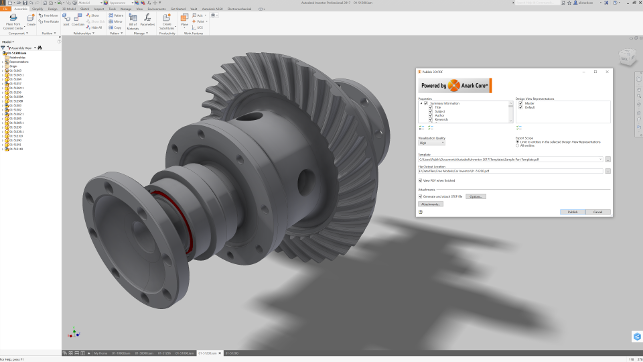
Inventor 2017 includes 3D PDF support (using Anark’s technology) with a good amount of control and flexibility in the generation of that PDF
Connect design shares
We’re starting to run out of space for this review and while there’s a whole load of other enhancements all across the board (the drawings have been worked on, as well as the Presentation environments for creating both technical documentation and animations), I wanted to round things out with a look at Connect Design Shares.
This technology is being rolled out across a lot of Autodesk’s products and it centres on using its cloud-based platform, A360, as the means to conduct live design reviews.
Essentially, using Inventor you can connect with a colleague, customer or supplier to discuss a part or assembly.
In Inventor, you kick start a live design review session and send the other party the link that’s generated. They then open this up in a browser (it’s pretty platform independent so that includes smart phones and tablets as well) and you’re instantly connected.
Both parties (or indeed, a group) can then view the data at the same time.
In addition to synchronised views, you also get a full set of inspection tools (for part and sub-assembly visibility).
Conclusion
The revitalised development curve for Inventor is heartening to see. It’s gained a following in many industries and is helping thousands of companies bring products to market and deliver on time.
While it may not gain the coverage it once did (Fusion takes a lot of the lime light), there’s a vein of innovation in the last few releases that can’t be denied.
For example, the introduction of Shape Generator shows that Autodesk is taking its set of simulation capabilities (which it has acquired over the last 10 years) and is finding ways of delivering interesting and, more importantly, useful tools to its Inventor customers.
Although Shape Generator gets a good boost with 2017, making it more usable in the real world, I don’t think they’re done with it yet.
Elsewhere in this release, the capabilities to assist with handling the complexity of large scale assemblies, complex parts as well as working with imported data efficiently will prove beneficial to those that take the time to learn the ins and outs.
Alongside the functional updates, there’s been a shift in how Inventor is sold.
Previously, Inventor was split into several product sets. Inventor Standard was for part, assembly and drawing creation, with some additional goodies.
Inventor Professional added in tools like Tube and Pipe design, wire harness and electrical design tools and much more.
This added cost and complexity to the sales process, which it seems Autodesk is trying to remove from the process — particularly with its view of moving away from perpetual licensing towards making subscription sales the standard.
From 2017 onwards, there’s no differentiation, everything is now rolled into the Inventor Professional product and Inventor Standard has been removed. The good news is that Autodesk has priced Pro at the Standard level.
Inventor is now over 10 years old and while there are newer systems on the market, it holds true that to achieve maturity, you need to live it and gain the benefits of a longer life. Its time on the market is showing in the richness of the functionality that it includes, but it’s also good to see that the development team are still pushing into new grounds for its user community.
There’s much to get excited about in this release, that builds on the work done in the last couple of years, both in terms of development and the acquisitions that Autodesk has made (particularly in the simulation world).
While Autodesk’s move to a subscription model might not suit some, the simple fact is that if you’ve invested in Inventor then you’ll want to see some return on that investment with a toolset that is up to date and current, as well as be on the lookout for new tools that can help you build better products or improve existing ones.
Inventor 2017 looks to be the first release in a cycle that should see users be able to do just that.
| Product | Inventor 2017 |
|---|---|
| Company name | Autodesk |
| Price | TBC |

